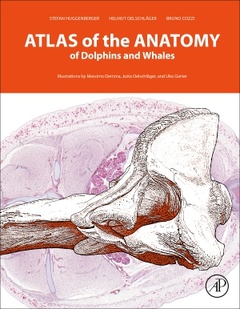Atlas of the Anatomy of Dolphins and Whales
Auteurs : Huggenberger Stefan, Oelschläger Helmut A, Cozzi Bruno

Atlas of the Anatomy of Dolphins and Whales is a detailed, fully illustrated atlas on the anatomy and morphology of toothed and whalebone whales. The book provides basic knowledge on anatomical structures, in particular, soft tissues, and functions as a standalone reference work for dissecting rooms and labs, and for those sampling stranded and by-caught dolphins in the field. As a companion and supplement to Anatomy of Dolphins: Insights into Body Structure and Function, this atlas will be of great interest to the scientific community, including veterinarians and biologists, as a book of reference. With a modern approach to dolphin anatomy and morphology, this atlas provides the extensive knowledge necessary to practitioners and theoretical scientists such as evolutionary biologists.
The conceptual clarity, precision, and comprehensive and updated display of the topographical anatomy of the body of cetaceans in the atlas support and illustrate the authors? related work, serving as a comprehensive reference for those who are more specifically interested in the details of the anatomy and morphology of porpoises, dolphins and whales.
Helmut Oelschläger (Dr.rer.nat.) is a senior lecturer, senior scientist and professor in human anatomy. After studying biology and chemistry in Tübingen (Germany) he made his Ph.D. and habilitation in Frankfurt am Main. He received several scientific awards and organized two marine mammal workshops (Kyoto and Tokyo 2000, Frankfurt 2001). Prof. Oelschläger is an experienced morphologist and neurobiologist and received numerous grants. Scientific topics are: the terminal nerve, magnetic orientation in mammals and the structure of the mammalian head and nervous system (sensory organs, brainstem, neocortex, ontogenetic development). His main focus lies on the comparative neurobiology and the evolution of whales and dolphins.
Bruno Cozzi obtained his degree in Veterinary Medicine (Dr. Med.Vet.) with honors in 1980 from the Faculty of Veterinary Medicine at the University of Milan (Italy) and his Ph.D. degree in 1993 from the Faculty of Health Sciences at the University of Copenhagen (Denmark). In 1999 he was appointed full professor of veterinary anatomy at the University of Padova (Italy).
His scientific production is focused mainly on comparative neuroendocrinology and neuroanatomy of large domestic herbivores, marine mammals, and
- Offers a single reference source and useful teaching tool for visualizing the integrated body and its components
- Functions as a helpful method for demonstrating the animal’s anatomy prior to dissection, and for teaching topographic and comparative anatomy
- Provides a unique and authoritative resource that explicitly relates the gross and microscopic anatomy of cetacean organs and tissues
- The prenatal development of dolphins is largely achieved
Date de parution : 11-2018
Ouvrage de 539 p.
21.4x27.6 cm
Thèmes d’Atlas of the Anatomy of Dolphins and Whales :
Mots-clés :
Axial muscles; Balaenoptera physalus; Blubber; Brain stem; Cerebellum; Cerebral cortex; Cranial nerves; Development; Epicranial complex; Globicephala melas; Grampus griseus; Hearing system; Heart; Kidney; Phocoena phocoena; Skeletal system; Spinal cord; Stenella attenuata; Stenella coeruleoalba; Stomach; Topographical anatomy; Tursiops truncatus; Ziphius cavirostris; Ziphius cavirostris Physeter macrocephalus



